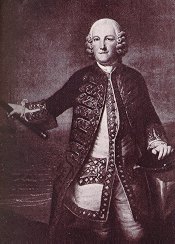
-
Admiral Anson
 (1697-1762).
(1697-1762).
 One would be hard pressed to find a man of the royal British navy who was more decorated and honoured than George Anson: As a 15 year old he entered the navy, at 21 an officer and by 27 he was the captain of his own naval ship. After a spectacular round the world trip, lasting three years and nine months, Anson was made a rear-admiral, in 1744. Having defeated the French fleet off of Cape Finisterre, in 1747, Anson was made a vice-admiral and raised to the peerage.1 He was made a full admiral in 1748; first lord of the admiralty. Not everyone thought that Anson was the best choice for the high rank of The First Lord of the Admiralty; "... a position in which he disappointed everyone."2 Yet, in 1761, and, just a year before his death, the 59 nine year old took the highest rank existing, admiral of the fleet.3
One would be hard pressed to find a man of the royal British navy who was more decorated and honoured than George Anson: As a 15 year old he entered the navy, at 21 an officer and by 27 he was the captain of his own naval ship. After a spectacular round the world trip, lasting three years and nine months, Anson was made a rear-admiral, in 1744. Having defeated the French fleet off of Cape Finisterre, in 1747, Anson was made a vice-admiral and raised to the peerage.1 He was made a full admiral in 1748; first lord of the admiralty. Not everyone thought that Anson was the best choice for the high rank of The First Lord of the Admiralty; "... a position in which he disappointed everyone."2 Yet, in 1761, and, just a year before his death, the 59 nine year old took the highest rank existing, admiral of the fleet.3
"Anson moved freely in the corridors of power." He was "very much a man of his age. His predominant characteristic was a rational calm which no adverse circumstance could shake."4 These characteristics, one might imagine were the characteristics of Warren and Boscawen, men who worked directly under Anson and who were promoted by Anson to high positions within the navy.
Incidentally, a number of important developments of the British navy came about during Anson's time. One was the progression of naval dress; a specific naval uniform emerged. "It was in Anson's time that a regular uniform was laid down for naval officers, though it was many years before the bulk of them readily conformed to it." Also, too, under Anson, the navy struck a system5 by which their warships were rated.